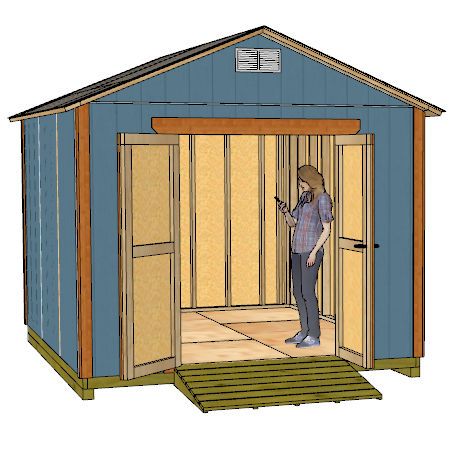- Back to Home »
- Diy 10x12 shed plans: tips for affordable construction

So, you're thinking about building your own shed! Awesome! A 10x12 shed is a great size for a workshop, storage space, or even a cozy little hangout. You’re going to be saving money and having a blast, but it's also important to be smart about it. That’s why we’re going to dive deep into how to build your 10x12 shed on a budget without sacrificing quality.
1. The Plan is the Key (and a Money Saver):
First things first, you need a plan. That doesn't necessarily mean hiring an architect, but at least having a solid idea of what you want to build. A simple sketch on graph paper with measurements can be a great start.
Pro Tip: Online resources like Pinterest and YouTube offer free shed plans, or you can find affordable plan sets from reputable companies.
2. Materials: The Hunt for Savings
You might be surprised by how much you can save by being resourceful.
A. Used Lumber:
Local Lumber Yards: Most lumber yards have used lumber, sometimes called "rejects," that's often a fraction of the price of new. Check for straight boards without major cracks or knots.
Craigslist and Facebook Marketplace: These are great for finding deals on used lumber and even building materials, but be sure to inspect everything carefully before buying.
B. Reclaimed Materials:
Demolition Sites: See if you can get your hands on reclaimed wood from old barns, houses, or sheds. Just make sure it’s treated and free of rot.
Salvage Yards: These can be treasure troves of building materials, often at significant discounts.
C. Smart Choices:
Pressure-Treated Lumber: While it's pricier, it's essential for the foundation and floor joists to resist moisture and rot.
Standard Sizes: Stick with standard sizes for plywood and lumber to avoid having to buy extra to make up for odd cuts.
3. Foundation: Building a Solid Base on a Budget:
The foundation is the most important part of your shed. It keeps it level, stable, and prevents rot.
A. Concrete Foundation:
DIY Concrete: Mixing your own concrete can save you money, but it’s a bit more labor-intensive.
Ready-Mix Concrete: While slightly more expensive, ready-mix is convenient and ensures a uniform mix.
B. Concrete Blocks:
Stacked Block Foundation: This is a relatively affordable option, especially if you can find used blocks.
Concrete Block Walls: For added durability, you can even use concrete blocks to build the shed's foundation walls.
C. Poured Concrete Slab:
Simplest Option: A poured concrete slab is a great option for a shed, but it requires more labor and can be pricier.
4. Framing: The Bones of Your Shed
The framing of your shed is the skeleton that supports the roof and walls.
A. Framing Lumber:
Pressure-Treated Floor Joists: Use pressure-treated lumber for your floor joists to prevent rot.
Standard 2x4s for Walls and Roof: Opt for standard 2x4s for the wall and roof framing.
B. Roof Truss or Rafters:
Trusses: These are pre-built and provide strength, saving you time and potential errors.
Rafters: Building your own rafters requires more knowledge and precision, but it can be more economical.
5. Siding and Roofing: The Shed's Outer Layer
The siding and roofing are what protect your shed from the elements.
A. Siding:
Vinyl Siding: It's affordable, low maintenance, and comes in a wide range of colors.
Wood Siding: Wood siding is a classic look, but it requires more maintenance.
Metal Siding: Metal siding is durable and fire-resistant, but it can be more expensive.
B. Roofing:
Asphalt Shingles: These are the most common and affordable option.
Metal Roofing: Metal roofing is durable and long-lasting, but it can be more expensive.
6. Doors and Windows: Completing the Look
Standard Doors: Use standard-size doors to save money. You can often find affordable doors at home improvement stores.
Single Windows: Opt for single-pane windows for a more budget-friendly approach.
7. Interior Finish: Personalizing Your Shed
Drywall: Drywall is a popular and affordable interior finish.
Painted Plywood: You can use plywood panels as a budget-friendly alternative to drywall and paint them to create a finished look.
Wood Paneling: Wood paneling adds warmth and character to your shed.
8. Don't Forget the Extras:
Electrical Wiring: If you plan to use electricity in your shed, budget for wiring and a breaker box.
Insulation: Insulating your shed can help keep it cooler in the summer and warmer in the winter.
Flooring: Add a layer of plywood subfloor and then choose flooring that fits your budget and needs.
9. DIY vs. Hiring Out:
DIY is Best for Savings: Building your shed yourself is the most cost-effective way to go.
Hiring Out for Specific Tasks: If you're not comfortable with certain tasks, such as pouring concrete or installing the roof, consider hiring a professional.
10. Safety First:
Power Tools: Use safety goggles, gloves, and ear protection when working with power tools.
Heavy Lifting: Get help with heavy lifting tasks.
Building Codes: Check local building codes and obtain any necessary permits before starting your project.
Final Thoughts:
Building your own 10x12 shed is a rewarding experience that can save you a lot of money. With a little planning, resourcefulness, and a DIY spirit, you can create a functional and stylish shed that you’ll enjoy for years to come. Remember, it’s about the process, not just the end result. So, grab your tools, put on your safety glasses, and get ready for a fun and fulfilling construction project!








